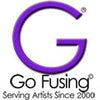
How to Use Bubble Paints
How To Use Fusible Glass Bubble Paints
GoFusing.com offers Fusible Glass Bubble Paints, in 11 vibrant Colors! (lead-free/food safe, 2 colors, red and yellow, do have a health warning but when covered with glass and fired will be food safe).
- The example on the left is a heavy dry application of Blue Green Bubble Paint powder sifted onto the base glass. (Note: edges had paint removed to allow a full contact of the glass layers for sealing in the bubbles during the fuse)
- The example on the top right was created using a lot of medium and a light sprinling of the bubble powder.
- The example on the bottom right was created using a brush to apply the medium where desired. Then applied a dusting of bubble paint over it. Turned it upside down and removed excess bubble paint in dry areas.
All examples were fired as a fast full fuse between two layers of glass.
The fused glass bubble paints are a powder formula and can be applied using any of the following techniques:
- Mix the bubble paint powder with the clear Bubble Paint Medium to control the paint. Apply with a brush to form into a design.
- Apply a layer of Glass Color Medium to the entire surface of the base glass and then sift over the colors desired. The more medium, the more transparent the bubbles and color will concentrate around the edges of each bubble, creating a translucent water color effect.
- Apply the Glass Color Medium to the surface of the base glass completely, then dry by sifting directly onto the glass before capping with clear glass. The heavier the application the more and larger the bubbles. There is a point where it can be applied too heavily and the bubble will expand so much that the top layer of glass becomes too thin at the top of the bubbles. This can result in stress cracks, so it is best to not apply too thick.
- NOTE: You should ALWAYS clean the bubble paint off the edges of the glass for 1/8 to 1/4 inch to allow the glass to bond cleanly with the base glass and encapsulate the bubbles.
- Mix the fused glass Fusible Glass Bubble Paints with any other color of Bubble paint to create new colors.
Glass Bubble paints can be used on COE 90 & COE 96 glass.
Firing glass bubble paints: Fire to a full fuse of at least 1450º F or cone 015-016 in a ceramic or a glass kiln. Fusing glass bubble paints are best fired at a fast full fuse as slower fuses can create an over abundance of bubbles with unfavorable results or if too slow, allow the bubbles to escape before the edges of the glass melt and seal them in.
We created a transparent effect with a heavy coat of Glass bubble paint medium and a light sift of dry bubble paint color before capping and firing.
Instructions for using Glass Bubble Paints:
1. Cleaning Glass: Clean both sides of the glass to remove all oils and dirt and then rinse well. Dry the glass with a lint free cloth or paper towel. After cleaning, handle glass by the edges only to insure the oil from your hands or your fingerprints will not show after firing your glass.
2. Using a palette knife place a small amount of color on tile or in paint well.
3. Create a Design: Add a few drops of Glass Bubble Paint Medium. Mix the bubble paint with either palette knife or brush, continue to add a drop or two and mix until you have the thickness of cream. Remember to mix only what you will use at that time and discard any that is left as it will no longer produce bubbles.
4. Using Dry Bubble Paints: Using a paint sifter you can apply directly to the glass or apply Glass Bubble Paint Medium with a brush to the desired areas to create a design and then use a glass sifter to cover the entire surface. Finally turn upside down and tap the back side of the glass to remove any excess bubble paint.
5. Intermixing Colors: Fusible Glass Bubble Paints, all colors can be intermixed to achieve additional shades of colors. If using either of the two red colors with health warning make sure not use them for food or fire them to the glass and then fuse a clear glass over them in a second firing so they will be food-safe.
Notes:
- Practice outlining on a scrap piece of glass until you are getting the desired results.
- Keep tip clean from drips or build-up of color by wiping it off on a damp sponge or paper towel.
- When the bottle is not in use you can leave it tip down in a damp sponge for a short amount of time, or clean tip with plunger and place cap on bottle to keep it from drying out. You can also add your signature with the outline color.
- Applying Color: Using a soft liner brush, load brush fully and drip, puddle, etc. in the center of the outlined area and push the color to the outline using the tip of the brush. Try not to go over your outlining. You can raise the glass up and look at it to see if you have even coverage and that the color is touching the outline. You can also use a light table/board to work on which will show you if the colors are solid and filled in and touching your outline.
- Choosing a selection results in a full page refresh.
!
